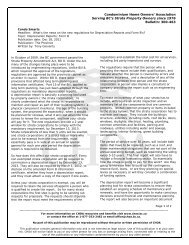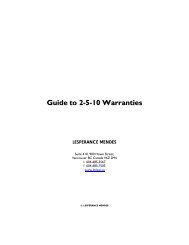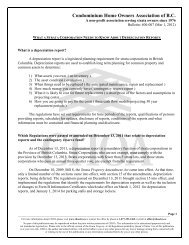December - CHOA
December - CHOA
December - CHOA
You also want an ePaper? Increase the reach of your titles
YUMPU automatically turns print PDFs into web optimized ePapers that Google loves.
Open joints collectwater and lead todeteriorated beamsand columns atthe connection.Things to Know About WoodKnowledge of the characteristics of wood canassist in making good decisions regarding themaintenance and replacement of exposed woodcomponents.All wood is susceptible to decay, however,the rate of deterioration varies depending onthe species. One of the most common types ofwood used in exterior applications is cedar. Cedarhas a natural resistance to decay, although overtime, given specific conditions, it may decay. Thedurability of other wood species can be increasedby means of chemical treatments.Factory applied preservative treatment, asopposed to field applied treatment, provides themost reliable protection. Alkaline copper quat(ACQ), copper azole (CA) and chromated copperarsenate (CCA) type preservatives are suitable forexposed exterior conditions, while borate typepreservatives are only suitable for situationsprotected from continuous exposure to liquidwater. Only preservative treated wood that hasbeen incised (small slots created in the sides of thewood so that preservative chemicals can penetratemore deeply) should be used when placed in contactwith soil. Field cuts, notches and holes should betreated with preservatives specifically intended forfield cuts as they are formulated to soak into thewood and penetrate well through the end grain.The most common reason for the replacementof exposed untreated wood structures is decay.Decay, or rot, occurs due to the growth of specificfungi which feed on the fibres in the wood.Exposure to fungal spores that develop intofungi cannot be avoided as the spores are foundeverywhere. These spores will germinate and growif the following four requirements are present:• oxygen• mild temperatures• moisture, and• suitable food (the wood).For exposed wood structures, control over oxygenand temperature is not possible. However, controlover the other two requirements is possible.Eliminating either one of these requirements willeliminate the potential for fungal growth and decay.Limiting Exposure to MoistureExterior wood elements come in contact withmoisture through exposure to rain or groundwater. A third possible form of exposure tomoisture, ambient exterior humidity, does notcause exposed wood to reach the requiredhigh moisture content levels that would allowdeterioration to occur.Whenever possible, it is recommended thatexposure to moisture be eliminated or minimized.Many exterior wood elements can be protectedfrom wetting by roofs or metal flashings. Slopingof horizontal wood surfaces for positive drainage,and detailing that allows drying, are some otherways to limit the time that moisture stays incontact with the wood.Exposure to moisture may also be limited bythe application of coatings such as paints orRoof or canopy structures minimize wettingof wood posts and beams.Metal cap flashing on exposed beam ends preventswater from collecting on the upper horizontalsurfaces.Homeowner Protection Office 2 Maintenance Matters No. www.hpo.bc.caContinued on page 27.<strong>CHOA</strong> Journal | <strong>December</strong> 2011 25








